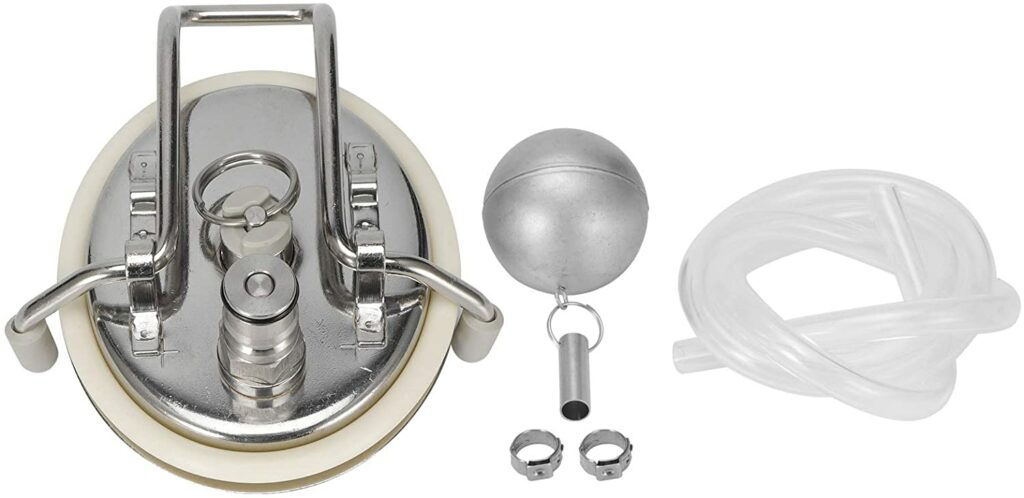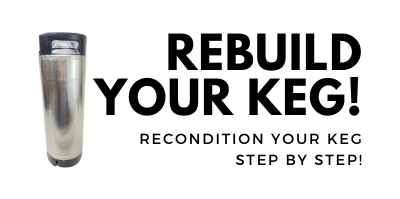
Ball Lock Post Equipped Lid + Floating Dip Tube
Bigking Brew Keg Lid,Stainless Steel Homebrew Carbonation Keg Lid with Beer Tube Floating Ball for Kegland Kegs
More InfoFrom the product description, check product page for current description, price and availability:
- 【Structural Features】With O‑ring and pressure relief valve, with good sealing performance, can hold pressure without leaks.
- 【For Your Convenience】Labor‑saving design of safety relief valve, no need to keep lifting when deflated, just lift once and rotate 90° to continuously deflate.
- 【Selected Materials】High‑quality 304 stainless steel material, high hardness, strong and durable.
- 【Save Installation Time】It is compact and portable, easy to install and use, large handle makes installation easier .
- 【Indispensable】Exquisite workmanship, long service life, which is a practical home brewing accessory.
- Works on Pin Lock AND Ball Lock Kegs! One difference between Pin Lock and Ball Lock kegs is the type of lids that come with each. Ball Locks, generally, have a manual PRV valve, while Pin Locks do not. Ball Lock style lids are, in my opinion, superior because the manual PRV allows you to easily vent your keg as needed. The good news is that, for standard kegs, the lids are the same size and can be interchanged. That means you can use a Ball Lock style lid in a Pin Lock Keg.
- Related: What’s the Difference Between Ball Lock Kegs and Pin Lock Kegs?
- Rebuild Your Kegs! Rebuilding & Reconditioning Homebrew Kegs! – step by step process for rebuilding & reconditioning homebrew kegs
Bigking Brew Keg Lid,Stainless Steel Homebrew Carbonation Keg Lid with Beer Tube Floating Ball for Kegland Kegs – affiliate link, note that multiple variations of this product may be available, as such a different version may appear at this link
My explanation of how floating dip tubes work…
When we carbonate a keg, pressure is being applied to the keg from the top, via the head space. Beer at the top carbonates first. That carbonation works it’s way down the keg. I’m sure there’s also some movement in the keg that helps to mix things up and distribute carbonation. But just sitting there, I think that mixing is a slow process. However it all works, practically speaking, the beer at the top carbonates more quickly compared to the beer at the bottom. This allows you to serve from the top accessing the more carbonated portion of the keg. It’s also a benefit for clarity because trub settles out heading downward. You can see this stratification in a glass carboy. As the beer starts to clear, the top clears first. I don’t think if this is exactly accurate, but I picture carbonation happening with the same sort of stratification until the beer reaches equilibrium and is equally carbonated throughout.
Also: Kegerator Tips & Gear | Keg Repair Part #s | Recent Keg Finds
Our Top Draft Resources!
Check our our Top Draft Related Resources- Commentary: Pin Lock Keg Pricing and Availability
- Check Your CO2 Regulator for Leaks!
- How to get a keg ready for first use? New Keg Cleaning and Prep
- Portable Draft Beer Serving Options!
- Pin Lock Keg Pricing and Availability
- The Most Difficult Spot to Check for CO2 Leaks
- Keg O-Ring Materials Selection! – EPDM, Silicone and Buna-N?
- Why Do I Have Bubbles in My Beer Line? Diagnosing and Fixing Kegerator Foam Problems
- Five Benefits of Using Corny Kegs As Fermenters
- Rebuilding & Reconditioning Homebrew Kegs!
- Food Safe Replacement Keg O-Rings in Bulk
- Hands on Review: Kegland DuoTight Fittings & EVABarrier Tubing!
- Why Won’t My Beer Carbonate? Fixing Draft Beer Carbonation Problems
- What Does a Flow Control Faucet Do?
- Upgrade Your Kegerator – 6 Improvements!
- Serve Homebrew on Any Kegerator & Convert Commercial Kegerator to Homebrew
- Tips and Gear for Growler Filling
- What’s the Difference Between Ball Lock Kegs and Pin Lock Kegs?
- Checking for Draft System CO2 Leaks – Using The Pressure Gauge Method
- Tip: Consider Oetiker Stepless Clamps for Kegerator Gas and Beer Lines
- Hands On Review: Inkbird ITC-308 Dual Stage Temperature Controller +WiFi Version
- Universal Poppets Tips and Tricks!
- Convert Your Mark II Keg & Carboy Washer to a Recirculating Draft Line Cleaning Pump!
- Step by Step: Finding and Fixing Keg CO2 Leaks
- Kegerator Temperature Probe Placement – To Immerse or Not To Immerse? – three tests to determine optimal pla…
- Kegerator Beer Line Temperatures & Reducing Foam with a Recirculating Fan
- Kegging CO2 Use Estimations and Calculations
- Balancing Your Kegerator Draft System
- Building a Simple Ball Lock Draft Line Flushing Setup
- Build a Recirculating Draft Line Cleaning Pump
- Home Brew Keg Roundup – New & Used, 5 and 2.5 Gallon & More!
- Damp Kegerator? Fix Kegerator Condensation
- Homebrew Temp Controller Roundup! – Kegerator and Fermentation – concepts, applications and models
- Bulk Keg Orings and Keg Parts Reference
This post contains affiliate links. We may make a commission when you use our Amazon links. This will never cost you extra. Thank you for supporting Homebrew Finds!
pinned amazon

